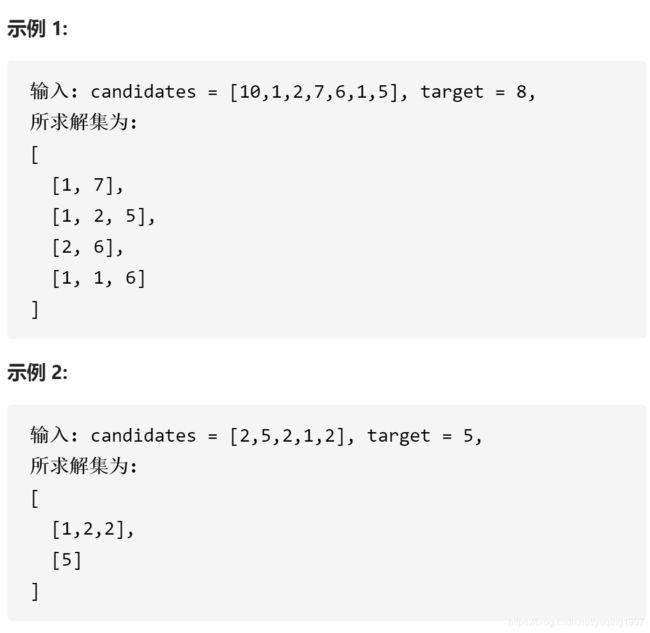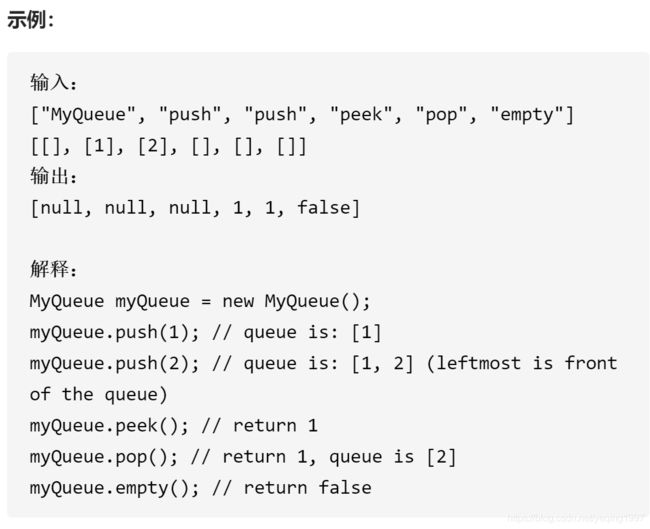0214leetcode刷题5道
40
题目描述:
给定一个数组 candidates 和一个目标数 target ,找出 candidates 中所有可以使数字和为 target 的组合。
candidates 中的每个数字在每个组合中只能使用一次。
说明:
所有数字(包括目标数)都是正整数。
解集不能包含重复的组合。
class Solution:
def combinationSum2(self, candidates: List[int], target: int) -> List[List[int]]:
candidates.sort()
size=len(candidates)
def helper(candidates,res,path,target,start,temp):
for i in range(start,size):
if candidates[i]==temp:
continue
path.append(candidates[i])
if sum(path)<target:
helper(candidates,res,path,target,i+1,temp)
elif sum(path)==target:
res.append(path[:])
path.pop()
return
else:
path.pop()
return
temp=path.pop()
res=[]
path=[]
temp=candidates[0]-1
helper(candidates,res,path,target,0,temp)
return res
119
题目描述:
给定一个非负索引 k,其中 k ≤ 33,返回杨辉三角的第 k 行。
在杨辉三角中,每个数是它左上方和右上方的数的和。
class Solution:
def getRow(self, rowIndex: int) -> List[int]:
row = [0] * (rowIndex + 1)
row[0] = 1
for i in range(rowIndex):
for j in range(i, 0, -1):
row[j] = row[j] + row[j-1]
row[i+1] = 1
return row
225
题目描述:
请你仅使用两个队列实现一个后入先出(LIFO)的栈,并支持普通队列的全部四种操作(push、top、pop 和 empty)。
实现 MyStack 类:
void push(int x) 将元素 x 压入栈顶。
int pop() 移除并返回栈顶元素。
int top() 返回栈顶元素。
boolean empty() 如果栈是空的,返回 true ;否则,返回 false 。
class MyStack:
def __init__(self):
"""
Initialize your data structure here.
"""
self.q=deque()
def push(self, x: int) -> None:
"""
Push element x onto stack.
"""
size = len(self.q)
self.q.append(x)
for _ in range(size):
self.q.append(self.q.popleft())
def pop(self) -> int:
"""
Removes the element on top of the stack and returns that element.
"""
return self.q.popleft()
def top(self) -> int:
"""
Get the top element.
"""
return self.q[0]
def empty(self) -> bool:
"""
Returns whether the stack is empty.
"""
return len(self.q)==0
# Your MyStack object will be instantiated and called as such:
# obj = MyStack()
# obj.push(x)
# param_2 = obj.pop()
# param_3 = obj.top()
# param_4 = obj.empty()
232
题目描述:
请你仅使用两个栈实现先入先出队列。队列应当支持一般队列的支持的所有操作(push、pop、peek、empty):
实现 MyQueue 类:
void push(int x) 将元素 x 推到队列的末尾
int pop() 从队列的开头移除并返回元素
int peek() 返回队列开头的元素
boolean empty() 如果队列为空,返回 true ;否则,返回 false
class MyQueue:
def __init__(self):
"""
Initialize your data structure here.
"""
self.instack=[]
self.outstack=[]
def push(self, x: int) -> None:
"""
Push element x to the back of queue.
"""
self.instack.append(x)
def pop(self) -> int:
"""
Removes the element from in front of queue and returns that element.
"""
if len(self.outstack) == 0:
while self.instack:
self.outstack.append(self.instack.pop())
return self.outstack.pop()
def peek(self) -> int:
"""
Get the front element.
"""
if len(self.outstack) == 0:
while self.instack:
self.outstack.append(self.instack.pop())
return self.outstack[-1]
def empty(self) -> bool:
"""
Returns whether the queue is empty.
"""
return len(self.instack) == 0 and len(self.outstack) == 0
# Your MyQueue object will be instantiated and called as such:
# obj = MyQueue()
# obj.push(x)
# param_2 = obj.pop()
# param_3 = obj.peek()
# param_4 = obj.empty()
剑指offer59-I
题目描述:
给定一个数组 nums 和滑动窗口的大小 k,请找出所有滑动窗口里的最大值。
class Solution:
def maxSlidingWindow(self, nums: List[int], k: int) -> List[int]:
'''
res = []
if not nums:
return res
for i in range(len(nums)-k+1):
res.append(max(nums[i:i+k:1]))
return res
'''
# 边界条件
if not nums:return []
if k == 1:return nums
if k == len(nums):return [max(nums)]
# 初始化第一个窗口,求出第一个窗口的最大值
max_tmp = max(nums[0:k])
res = [max_tmp]
# 开始滑动窗口,每滑动一次,左边抛出一个旧值,右边加入一个新值
n = len(nums)
for i in range(1, n - k + 1):
old = nums[i - 1] # 左边旧值
new = nums[i + k - 1] # 右边新值
if old < max_tmp:# 如果抛出的旧值小于当前窗口最大值,就与加入的新值进行比较
max_tmp = max(max_tmp, new)
if old >= max_tmp:# 如果抛出的旧值大于等于当前窗口最大值,就重新计算当前窗口的最大值
max_tmp = max(nums[i:i + k])
res.append(max_tmp)
return res




